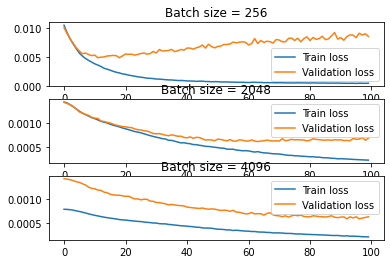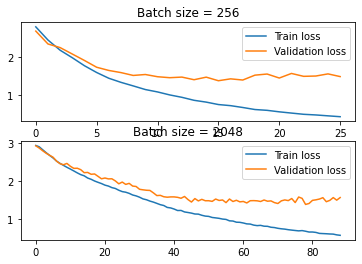Hello, I am writing a classifier that takes a surname and predicts a language it belongs to. I was experimenting with different batch sizes and found that small batch sizes (256 and less) perform poorly compared to big batch sizes (2048 and more). Could someone give me some insight on why this is happening? Thank you.
Training code:
def indices_to_packed(names, input_size):
names = [F.one_hot(item, input_size).float() for item in names]
names_packed = pack_sequence(names, enforce_sorted=False)
return names_packed
def infer(model, data, labels, lengths, device):
data_packed = indices_to_packed(data, model.rnn.input_size)
data_packed, labels, lengths = data_packed.to(device), labels.to(device), lengths.to(device)
preds = model(data_packed, lengths)
loss = loss_fn(preds, labels)
return loss, preds
results = {}
epochs = 100
for BATCH_SIZE in [256, 2048, 4096]:
train_loader = data.DataLoader(train_data, BATCH_SIZE, sampler=train_sampler, collate_fn=partial(my_collate, input_size=input_size, output_size=output_size))
val_loader = data.DataLoader(val_data, BATCH_SIZE, sampler=val_sampler, collate_fn=partial(my_collate, input_size=input_size, output_size=output_size))
model = LSTM(input_size, HIDDEN_SIZE, NUM_LAYERS, DROPOUT, output_size)
optimizer = torch.optim.Adam(model.parameters())
model.to(device)
train_losses = []
val_losses = []
cur_losses = {}
duration = 0
for epoch in range(epochs):
start = time.time()
train_loss = 0
model.train()
# Using PackedSequence
for names, langs, lengths in train_loader:
optimizer.zero_grad()
loss, _ = infer(model, names, langs, lengths, device)
loss.backward()
optimizer.step()
train_loss += loss
train_loss /= len(train_data)
train_losses.append(train_loss.cpu().detach().numpy())
model.eval()
val_loss = 0
with torch.no_grad():
for names, langs, lengths in val_loader:
loss, _ = infer(model, names, langs, lengths, device)
val_loss += loss
val_loss /= len(val_data)
val_losses.append(val_loss.cpu().detach().numpy())
cur_duration = time.time() - start
duration += cur_duration
log_line = (f"BATCH_SIZE: {BATCH_SIZE} epoch: {epoch} train loss: "
f"{train_loss:.5f} val loss: {val_loss:.5f}")
print(log_line)
cur_losses["train_losses"] = train_losses
cur_losses["val_losses"] = val_losses
results[BATCH_SIZE] = {"losses" : cur_losses, "duration" : duration, "model": model}
Model:
class LSTM(nn.Module):
def __init__(self, input_size, hidden_size, num_layers, dropout, output_size):
super().__init__()
self.rnn = nn.LSTM(input_size, hidden_size, num_layers, dropout=DROPOUT)
self.linear = nn.Linear(hidden_size, output_size)
self.softmax = nn.LogSoftmax(dim=1)
def forward(self, x, lengths):
lstm_out, _ = self.rnn(x)
# https://discuss.pytorch.org/t/get-each-sequences-last-item-from-packed-sequence/41118/7
sum_batch_sizes = torch.cat((
torch.zeros(2, dtype=torch.int64),
torch.cumsum(lstm_out.batch_sizes, 0)
))
sorted_lengths = lengths[lstm_out.sorted_indices]
last_seq_idxs = sum_batch_sizes[sorted_lengths] + torch.arange(lengths.size(0))
last_seq_items = lstm_out.data[last_seq_idxs]
lstm_last_out = last_seq_items[lstm_out.unsorted_indices]
linear_out = self.linear(lstm_last_out)
softmax_out = self.softmax(linear_out)
return softmax_out

